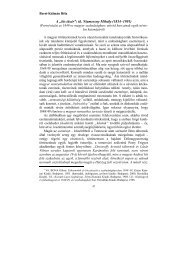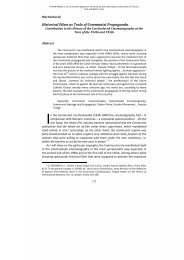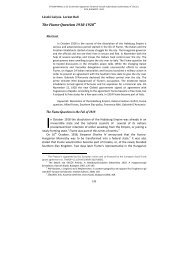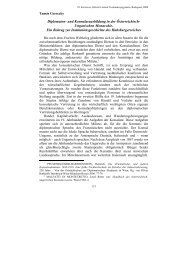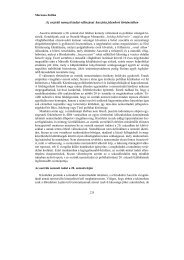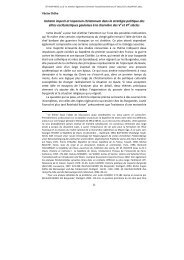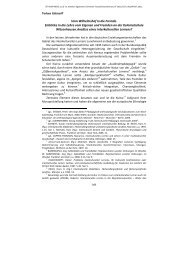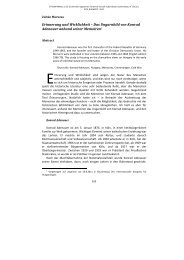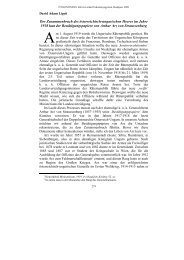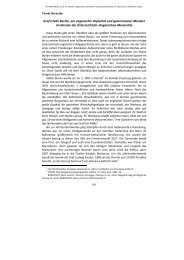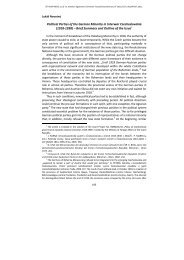The Molotov-Ribbentrop Pact - ELTE BTK Történelem Szakos Portál
The Molotov-Ribbentrop Pact - ELTE BTK Történelem Szakos Portál
The Molotov-Ribbentrop Pact - ELTE BTK Történelem Szakos Portál
You also want an ePaper? Increase the reach of your titles
YUMPU automatically turns print PDFs into web optimized ePapers that Google loves.
<strong>The</strong> Polish Minority in Prussia and the German Empire<br />
In 1871 6,2% of the German population in the Empire were of Polish<br />
nationality. Most lived in the eastern provinces of Prussia. <strong>The</strong> Polish minority was<br />
especially represented in the areas gained by the Partition of Poland at the end of<br />
the 18 th century: the provinces of Poznań and West-Prussia. Around the city of<br />
Poznań Polish-speaking inhabitants constituted the majority of the population.<br />
After the congress of Vienna (1815) the Poles enjoyed a relatively<br />
autonomous status in the dynastical state of Prussia. Poznań was constituted as a<br />
Grand Duchy with certain rights to self-governance until the November uprising<br />
of 1830. 4 After that the Poles experienced a growing pressure to assimilate, at<br />
first motivated by policies to strengthen the integrity of the Prussian state. But<br />
Prussian authorities also launched a growing ethnically and culturally motivated<br />
assimilation campaign towards the Polish population, mainly aiming at the<br />
cultural attributes of language and religion. 5 With the foundation of the German<br />
Empire in 1871 the Polish minority experienced a dramatic change of<br />
environment. <strong>The</strong> new Empire claimed to be a nation-state by denying the<br />
existence rights of minorities within its borders. <strong>The</strong> first measures were<br />
restrictions in the use of the Polish language in schools and public meetings. In<br />
the Cultural Dispute (Kulturkampf) around 1872, the government repressed the<br />
influence of the catholic church in the public sphere. <strong>The</strong> Poles were especially<br />
affected, since many Polish-speaking priests who worked as teachers were now<br />
replaced by German-speaking civil servants and teachers. 6 This process of anti-<br />
Polish measures by the Prussian government marks the beginning of the attacks<br />
against the Polish cultural identity within the German Empire, also known as the<br />
campaign of Germanisation.<br />
<strong>The</strong> Pan-German League and its ideology<br />
<strong>The</strong> repressive policies of the Prussian government in the last third of the<br />
19 th century were not satisfying to big parts of the German nationalistic middle<br />
and upper class. Wide circles organized themselves into political interest<br />
groups, promoting an ethnically and culturally homogeneous state. <strong>The</strong>y<br />
demanded the full integration and assimilation of minorities, including the<br />
liquidation of their identity. 7<br />
4<br />
MAKOWSKI, Krzysztof: Polen, Deutsche und Juden und die preußische Politik im<br />
Großherzogtum Posen. Versuch einer neuen Sicht. In: HAHN-KUNZE (ed.): Nationale Minderheiten<br />
und staatliche Minderheitenpolitik in Deutschland im 19. Jahrhundert. Berlin, 1999. 51-60.<br />
5<br />
ALEXANDER, Manfred: Kleine Geschichte Polens. Bonn, 2005 (first: Stuttgart, 2003.). 246.<br />
6<br />
TRZECIAKOWSKI, Lech: <strong>The</strong> Kulturkampf in Prussian Poland. New York, 1990 (first<br />
Polish: Kulturkampf w zaborze pruskim. Poznań, 1970). 5.<br />
7<br />
HERING, Rainer: Konstruierte Nation. Der Alldeutsche Verband 1890 bis 1939. Hamburg,<br />
2003. 443.<br />
46



